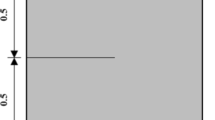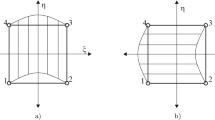Abstract
Fatigue is a major cause of failure in several industries, and in many practical cases, local mixed-mode conditions prevail at the crack front. The effect of plane mode mixity on the crack growth rate and crack growth direction has been investigated. Fatigue crack growth experiments have been conducted on aluminum alloy Al5083-H111 for several mode mixities. A fixture was manufactured in order to apply the different combinations of mode I and II by changing loading angle. Afterward, three-dimensional simulations have been implemented using the Zencrack software. Based on numerical simulations, new relations are proposed to estimate stress intensity factors for compact tension shear geometry by modifying Richard’s equations [1].















Similar content being viewed by others
References
Richard HA (1985) Fracture mechanical predictions for cracks with superimposed normal and shear loading. VDI-Forschungsheft 631/85. Düsseldorf (in German)
Kaufman JG (2000) Introduction to aluminum alloys and tempers. ASM International, Ohio
Richard HA, Schramm B, Schirmeisen N (2014) Cracks on mixed mode loading–theories, experiments, simulations. Int J Fatigue 62:93–103
Biner SB (2001) Fatigue crack growth studies under mixed-mode loading. Int J Fatigue 23:S259–S263
Borrego LP, Antunes FV, Costa JM, Ferreira JM (2006) Mixed-mode fatigue crack growth behaviour in aluminium alloy. Int J Fatigue 28:618–626
Heirani H, Farhangdoost K (2017) Mixed mode I/II fatigue crack growth under tensile or compressive far-feld loading. Mater Res Express 4:1–11
Richard HA, Benitz K (1983) A loading device for the creation of mixed mode in fracture mechanics. Int J Fract 22:R55–R58
Qian J, Fatemi A (1996) Mixed mode fatigue crack growth: a literature survey. Eng Fract Mech 55:969–990
Wu CH (1978) Fracture under combined loads by maximum-energy-release-rate criterion. J Appl Mech 45:553–558
Erdogan F, Sih GC (1963) On the crack extension in plates under loading and transverse shear. J Basic Eng 85:519–527
Sih GC, Barthelemy BM (1980) Mixed mode fatigue crack growth predictions. Eng Fract Mech 13:439–451
Richard HA (1988) Safety estimation for construction units with cracks under complex loading. Int J Mater Prod Technol 3:326–338
Lesiuk G, Kucharski P, Correia JAFO, De Jesus AMP, Rebelo C, Simões da Silva L (2016) Mixed mode (I + II) fatigue crack growth of long term operating bridge steel. Procedia Eng 160:262–269
ASTM E647-15e1 (2015) Standard test method for measurement of fatigue crack growth rates. American Society for Testing and Materials, West Conshohocken
Zentech International Limited (2015) Zencrack User Manual, Version 7.9-3. Zentech International Limited, London
ASTM E8/E8M-09 (2009) Standard Test Methods for Tension Testing of Metallic Materials. American Society for Testing and Materials, West Conshohocken
Costa JD, Branco CM, Radon JC (1997) Short fatigue crack growth behaviour in Al 5083 alloy. Int J Fatigue 19(2):161–168
Dassault Systèmes (2014) Abaqus Product Documentation: Abaqus Analysis User’s Manual, Version 6.14-2. Dassault Systèmes, Providence
Shahani AR, Shakeri I, Rans CD (2020) Two engineering models for predicting the retardation of fatigue crack growth caused by mixed mode overload. Int J Fatigue 132:105378. https://doi.org/10.1016/j.ijfatigue.2019.105378
Shih CF (1974) Small-scale yielding analysis of mixed mode plane strain crack problem. ASTM STP 560:187–210
Richard HA, Linnig W, Henn K (1991) Fatigue crack propagation under combined loading. Forensic Eng 3:99–109
Díaz JG (2018) Linear elastic fracture mechanics analysis of fatigue crack growth under complex loading using the Digital Image Correlation technique. PhD Thesis. Pontifícia Universidade Católica Do Rio De Janeiro. https://doi.org/10.17771/pucrio.acad.36283
Richard HA, Fulland M, Sander M (2004) Theoretical crack path prediction. Fatigue Fract Eng Mater Struct 28:3–12
Shahani AR, Shakeri I (2020) Experimental evaluation of fatigue behavior of thin Al5456 welded joints. Fatigue Fract Eng Mater Struct 43(5):965–977
Vormwald M, Hos Y, Freire JLF, Gonzáles GLG, Díaz JG (2018) Crack tip displacement fields measured by digital image correlation for evaluating variable mode-mixity during fatigue crack growth. Int J Fatigue 115:53–66
Shahani AR, Shakeri I, Rans CD (2020) Effect of residual stress redistribution and weld reinforcement geometry on fatigue crack growth of butt welded joints. Int J Fatigue 139:105780. https://doi.org/10.1016/j.ijfatigue.2020.105780
Sander M, Richard HA (2006) Experimental and numerical investigations on the influence of the loading direction on the fatigue crack growth. Int J Fatigue 28:583–591
Richard HA, Schramm B, Eberlein A, Kullmer G (2013) Cracks under mixed mode loading: Questions and solutions for isotropic and graded materials. In: 13th International Conference on Fracture, Beijing, pp 16–21
Diaz JG, Gonzales G, Gonzalez JAO, Freire J (2017) Analysis of mixed-mode stress intensity factors using digital image correlation displacement fields. In: 24th ABCM International Congress of Mechanical Engineering, Curitiba, Brazil
Yang Y, Vormwald M (2017) Fatigue crack growth simulation under cyclic non-proportional mixed-mode loading. Int J Fatigue 102:37–47
Funding
This research did not receive any specific grant from funding agencies in the public, commercial or not-for-profit sectors.
Author information
Authors and Affiliations
Corresponding author
Ethics declarations
Conflicts of interest
All the authors declare that they have no conflict of interest.
Additional information
Technical Editor: João Marciano Laredo dos Reis.
Publisher's Note
Springer Nature remains neutral with regard to jurisdictional claims in published maps and institutional affiliations.
Rights and permissions
About this article
Cite this article
Shahani, A.R., Shakeri, I. & Rans, C.D. Fatigue crack growth of Al 5083-H111 subjected to mixed-mode loading. J Braz. Soc. Mech. Sci. Eng. 42, 442 (2020). https://doi.org/10.1007/s40430-020-02527-8
Received:
Accepted:
Published:
DOI: https://doi.org/10.1007/s40430-020-02527-8




